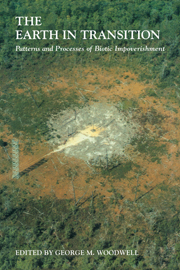Book contents
- Frontmatter
- Contents
- Preface
- Acknowledgments
- List of Contributors
- Part I Global Change and the Patterns of Impoverishment
- Part II Chronic Disturbance and Natural Ecosystems: Forests
- Part III Chronic Disturbance and Natural Ecosystems: Woodlands, Grasslands, and Tundra
- Part IV Chronic Disturbance and Natural Ecosystems: Aquatic and Emergent Ecosystems
- Part V Conclusion: Steps toward a World That Runs Itself
- 25 Steps toward Sustainability
- 26 A Reaction from a Multitude
- Name Index
- Subject Index
25 - Steps toward Sustainability
Published online by Cambridge University Press: 24 November 2009
- Frontmatter
- Contents
- Preface
- Acknowledgments
- List of Contributors
- Part I Global Change and the Patterns of Impoverishment
- Part II Chronic Disturbance and Natural Ecosystems: Forests
- Part III Chronic Disturbance and Natural Ecosystems: Woodlands, Grasslands, and Tundra
- Part IV Chronic Disturbance and Natural Ecosystems: Aquatic and Emergent Ecosystems
- Part V Conclusion: Steps toward a World That Runs Itself
- 25 Steps toward Sustainability
- 26 A Reaction from a Multitude
- Name Index
- Subject Index
Summary
My assignment has been to listen, reflect on what I have heard, and offer some final comments from the perspective of someone who, for good or ill, has been in our nation's capital working on environmental policy, both domestic and international, for almost twenty years.
The research represented in this volume certainly shows the limitations of the “one-pollutant/one-effect” approach to environmental regulation. That's not the way natural systems work. It is not consistent with the goal “design with nature.” When we look at natural systems, we see multiple stresses – chemical and physical, natural and humanly generated. The benefit of these critiques of one-pollutant/one-effect is that they force us to focus beyond individual pollutants to the underlying processes that generate pollution.
The widespread global effects of pollutants on natural biological systems are demonstrated clearly. In regulatory circles there has been a tendency to think of pollution principally in terms of health effects. That has certainly been the dominant thrust of EPA initiatives in recent years. As a useful corrective, this work calls attention forcefully to the long-term, cumulative effects of pollutants on the biota.
Similarly, this work focuses attention on the chronic, insidious changes caused by multiple stresses on biological systems. We tend to think more of dramatic “physical” changes – deforestation, desertification, extinction, and so on. Now we must be aware of more subtle biological erosion and impoverishment. An analogy to human health may be useful. We have concerns with both sickness and death.
- Type
- Chapter
- Information
- The Earth in TransitionPatterns and Processes of Biotic Impoverishment, pp. 509 - 512Publisher: Cambridge University PressPrint publication year: 1991

